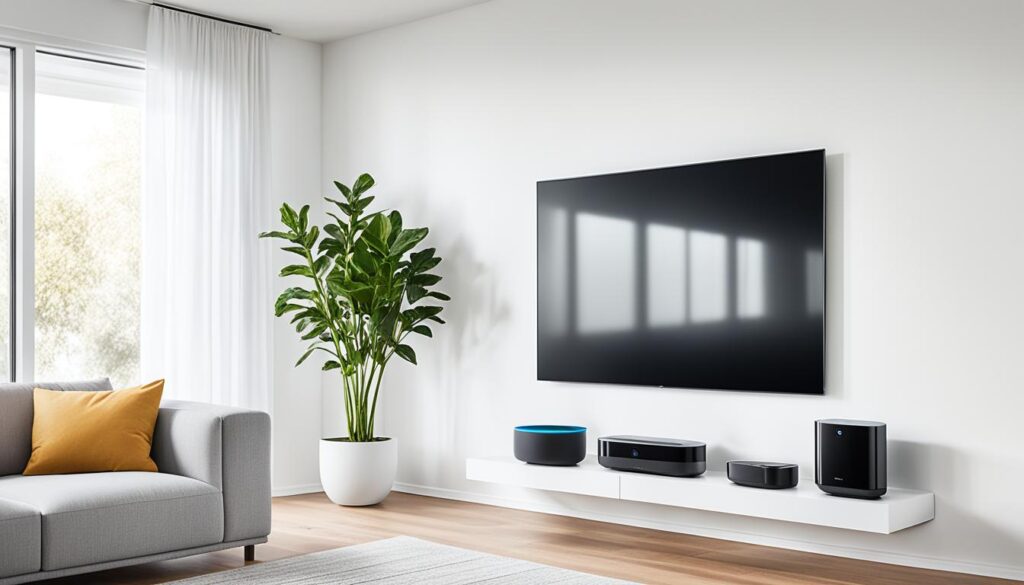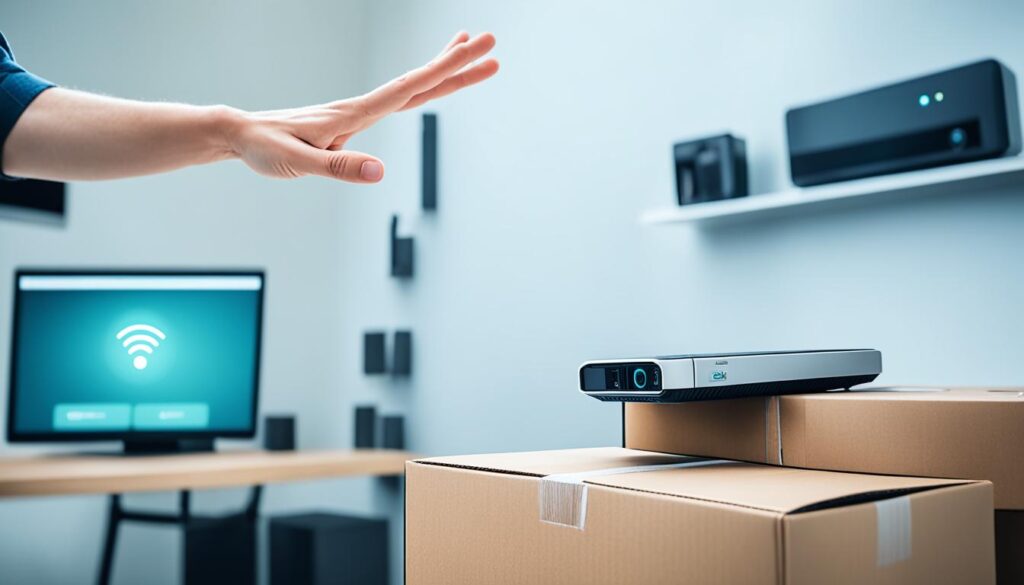Setting up your smart home is about unlocking convenience and efficiency. But it can also be overwhelming. There are many ecosystems, standards, and device options out there. This guide will walk you through key steps to create your ideal smart home setup.
You’ll learn how to choose the right smart home ecosystem. You’ll find out how to set up a central hub and optimize your home Wi-Fi. We’ll also cover how to connect devices, understand important standards, and customize automations. Security and troubleshooting issues are also important parts we’ll address. By the end, you’ll feel ready to turn your living space into a top-notch, voice-controlled smart home that fits your needs and style.
Key Takeaways
- Understand the top smart home ecosystems like Google Home, Amazon Alexa, and Apple HomeKit to choose the best fit for your needs.
- Leverage a smart hub to simplify device management and enhance your home automation experience.
- Optimize your home Wi-Fi network to ensure reliable connectivity for all your smart devices.
- Verify device compatibility with your chosen ecosystem to create a seamless, integrated smart home.
- Automate and customize your smart home setup to streamline daily tasks and enhance convenience.
Choose Your Smart Home Ecosystem
Before getting smart home devices, pick your ecosystem base.1 Your choices are Google Home, Amazon Alexa, and Apple HomeKit.2 Each has unique benefits for your smart home setup.
Google Home Ecosystem
The Google Home uses Google Assistant, which responds quickly and talks like a human.2 It works well with many smart products. So, it’s great for Google fans.
Amazon Alexa Ecosystem
Amazon Alexa connects with the most smart home gadgets by far.2 Devices like Echo give strong voice control. They work with lots of lights, appliances, and more.
Apple HomeKit Ecosystem
Apple HomeKit might work with fewer devices, but it’s super reliable.2 It fits well with iPhones and offers secure video features. This makes it good for Apple users.
Your choice should fit with the gadgets you already own.1 Think about which voice assistant you like best. This, along with the ecosystem’s strengths, will guide your decision.
Set Up a Smart Hub
Controlling smart devices with their apps works fine. Yet, using a smart hub can do more for your smart home experience. It brings everything together under one control. This makes managing your home’s smart features easy.
Benefits of Using a Smart Hub
A smart hub brings many advantages to your home automation:
- Central control of all your connected devices through a single app or voice interface
- Improved device integration and coordination, allowing seamless interactions between smart home components
- Enhanced voice control capabilities, enabling you to manage your home with simple voice commands
- Simplified device management and troubleshooting
- Potential for advanced automation and customization options
Popular Smart Hub Options
Here are some top smart home hubs you can find:
- Amazon Echo Show: A versatile smart display that acts as a control center for your smart devices.23
- Google Nest Hub: A smart display that works well with the Google Home system for easy device control.2
- Apple HomePod: A premium smart speaker that runs your Apple HomeKit smart home.2
- Samsung SmartThings: A smart home hub with broad device support and many customization choices.23
- Wink Hub: A smart home hub that uses different wireless standards, such as Zigbee and Z-Wave.23
Pick a smart hub that fits with your favorite smart home ecosystem. Think about how many devices it can connect, how easy it is to use, and special features you might need.

Optimize Your Home Wi-Fi
A strong home Wi-Fi system is key for any smart home. Most smart devices connect through Wi-Fi, so it’s vital your wireless setup is top-notch.4 Making your wireless network better improves how devices connect and work together.
Understanding Wi-Fi Frequencies
Wi-Fi uses two main bands: 2.4GHz and 5GHz. The 2.4GHz is good for longer distances but can get crowded. The 5GHz band is faster but covers less area. Knowing this helps you set up your network for the best smart home performance.4
Reducing Wi-Fi Congestion
With more connected devices, Wi-Fi can slow down or drop. There are ways to fix this, like placing your router well, reducing interference, and using the 5GHz band. These steps can cut down Wi-Fi congestion and keep your smart home running smoothly.4
Upgrading Your Router
If your router is old or can’t keep up, it’s time for a new one. The latest Wi-Fi 6 routers and mesh systems support more devices and cover a bigger area.4 A better wireless network from a new router means a more dependable smart home.5
Connect Smart Home Devices
Connecting your smart home devices offers three main paths: Bluetooth, Wi-Fi, or a smart home hub.2These devices connect through Bluetooth, Wi-Fi, or smart hubs for stable links.
Bluetooth, Wi-Fi, or Smart Hubs?
Bluetooth links are common for simple connections, like putting a phone with a speaker.2On the other hand, Wi-Fi connects more smart home items to your network.2More than half of smart devices use Wi-Fi and phone apps for control.6Smart hubs like Google Home or Amazon Echo make setup easier.2Hubs are a central control, letting you manage all smart devices from one spot.2Devices using wireless Zigbee and Z-Wave protocols are quite popular.
Verifying Smart Home Support
It’s vital to check that new smart devices work with what you already have.2Watch for “Works with Google Assistant,” “Works with Alexa,” or “Works with Apple HomeKit” logos.2Most people like devices that link to a variety of systems for future use.
By knowing your connection options and checking for compatibility, you can smoothly set up your smart home.
Understand Smart Home Standards
The smart home tech world uses many wireless protocols and standards. They help devices talk to each other and your main control system. Knowing about these smart home standards like interoperability and device compatibility is crucial. It makes sure your home automation works smoothly and together.2
Z-Wave is a top smart home standard, with over 26,000 products that work with it in 2019. This shows it’s a common tech choice.7 Zigbee is another well-known protocol. It makes safe networks with digital radios. It’s cheaper than WiFi or Bluetooth yet keeps your network safe.7
Amazon Alexa shines with more than 100,000 skills in 2021. It works with a wide range of IoT devices.7 On the other hand, Google Assistant offered more than 4,200 actions by 2019. It’s the second favorite voice assistant in smart homes.7
The new Matter standard wants to make smart homes easier. It supports nine new types of devices, making it 19 in total.8 There are already 1,200 products certified for Matter. And more than 300 companies are backing it. Matter has a lot of support to become a key smart home standard.8
To make the most of smart home tech, learning about these standards and systems is key. It helps you create a smart home that works well for you, now and in the future.
Smart Home Setup
Choosing your smart home system is the first step. Next, think about where to put your devices.2 Place your smart devices wisely around your house to make the most of them.2 This makes voice control and management easier. Also, give them clear names. This makes everything simpler to understand and control.
Finding Optimal Device Locations
Think about where to put smart devices like speakers and cameras in your home.2 They should go where you use them most, like the living room.2 This way, you can control them easily. Make sure they’re close to Wi-Fi for the best connection.
Naming Devices
Give your gadgets clear names to keep things neat.2 Instead of “Bedroom Light,” try “Master Bedroom Lamp.”2 This helps you tell them apart and command them better.

Automate and Customize
Setting up a smart home lets you control and adjust many parts of your home.2 You can group devices and make routines that fit your life. This makes your day easier and more convenient.2
Grouping Devices
Group your smart devices by where they are or what they do. For instance, make a group for the bedroom with smart lights, a thermostat, and a voice assistant. Or make a “Living Room” group including a smart TV, speakers, and lighting. Doing this, you can control many things at once. Use one voice command or your smart home app to do it.2
Creating Routines and Automations
After organizing, create routines and automations for easy living.2 Picture waking up to your lights turning on, your favorite music playing, and the temperature just right – all with a simple command. Or, have your home ‘go to sleep’ when you are not there, turning off lights, locking doors, and adjusting the temperature.2
Set up automations using time, day, or location triggers. For example, have your porch lights turn on as it gets dark. Or, let your home adjust its temperature as you arrive. The options are endless. You can make your smart home fit your life perfectly.2
Integrating smart home automation and setting up groups and routines will change your home.2 You’ll have a voice-controlled home that meets your needs exactly. This level of home customization and voice commands will make your life easier and more comfortable.2
Moving or Changing Routers
Are you moving to a new home or getting a new router? It’s key to know how these shifts can affect your smart home gear. This way, you can smoothly reconnect your devices.
When you move, it can take 4 to 6 weeks for your internet provider to update your address.9 During this time, your devices might have trouble staying connected. If you had Zigbee or Z-Wave devices, you might need more boosters in your new place.9
To move without problems, pack your Wi-Fi hub first. Then, set up your new Wi-Fi network. Next, connect your hub to this new network. Make sure to follow the right steps when deploying your smart devices.9 Changing the name and password on your new router can easily reconnect your devices.9
For devices like Zigbee and Z-Wave, connect your hub to your router with a cable. Then, reset each device to link them with the new network.9

Prioritize Smart Home Security
As you set up your smart home, making security a top priority is essential. This includes keeping your devices safe and the data they share private.
Setting up strong security on your network is key. This can keep your home and personal info safe from potential harm.10
Securing Wi-Fi Network
The Internet of Things has expanded with more devices in our homes. But, this makes our networks more open to cyber attacks.10 Make sure your Wi-Fi is safe by using tough passwords, turning on encryption, and updating your router often.11
Enabling Two-Factor Authentication
Protecting your network is just the start. Use two-factor authentication to add a second shield to your smart devices and accounts.10 This stops anyone unwelcome from getting into your systems and data, like photos, videos, and your online actions.11

Focusing on smart home security is crucial. By securing your network and using strong login measures, you can lower the risks of online threats. This protects your privacy within your smart home.1011
Troubleshooting Tips
Sometimes, your smart home might not work as you want it to.12 Figuring out what’s wrong really helps keep everything running smoothly.
Identifying Connectivity Issues
Smart homes often face a big challenge: keeping devices connected.12 They use different types of wireless connections. This can make it hard for devices to talk to each other.
To fix connection issues, check if your device is on the right network.12 Make sure your Wi-Fi password is correct.
If that doesn’t work, update your device’s software and give your router a restart. Also, move the device closer to the router. This can improve the signal.12 Updating your router’s settings or getting a new one might also help. Especially if you have a lot of devices connected.
Resetting Devices
Devices can get slow if they gather dust.13 Some devices need you to update them yourself. They won’t do it automatically. The manufacturer’s guide can help you keep your devices running well.
If a device stops working or the internet drops, try turning off the power. Then, check the lights on your internet router.13 Always keep your apps up to date. If a device still won’t work, ask the manufacturer for help.
Sometimes, you might need to reset a device. Find a small reset button on it. Follow the manufacturer’s guide to do this.13 It’s also important to keep your device subscriptions current.
If you can’t fix a problem, look online for solutions. You can also watch how-to videos. Or check the manufacturer’s advice and FAQs.13 If all else fails, consider getting professional help, either from the company or a smart home repair service.
For ongoing internet problems, call your internet provider. They might be able to help further.13

Smart Voice Assistants
At the core of the smart home is voice control. It allows you to use your voice to operate devices like smart speakers and voice assistants.14 By adding smart voice assistants like Google Assistant or Amazon Alexa, your smart home gets even better. It makes everything simpler and more accessible.14
Setting Up Voice Control
First, get a smart voice assistant that works with your home devices. This can be a smart speaker or smart display, like Google Nest Hub. Then, connect it to your smart home. Devices like lights and security systems can now be controlled with your voice.
Using Voice Commands
Once set up, you can control your smart home with voice commands.14 You can do simple things like adjust lights or play music. You can also do more complex actions like setting thermostat temperatures.14 Over time, you’ll make custom commands to do multiple things at once, improving your home’s convenience with every voice prompt.

Conclusion
Creating a smart home may feel overwhelming at first. But, if you take it one step at a time, you can have a modern, voice-controlled home. This home will fit your lifestyle perfectly. To start, choose the best smart home tools15. Set up a central hub, improve your Wi-Fi, and connect your devices properly.
As your smart home grows, keep up with the newest rules16. Make things automatic and focus on keeping your data safe. Yes, starting can be pricey1716. But, smart homes increase the value of your property17. Plus, you might get breaks on your insurance15.
Using this guide, you will feel ready to turn your home into a high-tech, smart place. It will use voice control and technology to make life better. Whether you begin with a few smart things or go all-in, the journey is fun. It will keep getting better and make your days more enjoyable. Enjoy setting up your smart home!
FAQ
What are the main smart home ecosystems to consider?
The big three smart home ecosystems are Google Home, Amazon Alexa, and Apple HomeKit. Each brings something different to the table. They all have their strengths and work slightly differently.
What are the benefits of using a smart home hub?
Having a smart home hub means you can control everything in one place. It makes managing your smart devices much easier and more straightforward.
Why is a reliable Wi-Fi network important for a smart home?
A good Wi-Fi network is a must for smart homes. It’s how devices talk to each other. If your Wi-Fi is weak, your smart devices won’t work well.
What are the main options for connecting smart home devices?
When connecting devices, you have three main choices: Bluetooth, Wi-Fi, or a hub. Each option has its uses depending on the device and your needs.
Why is understanding smart home standards important?
Knowing the tech behind smart devices helps everything work together. It’s like speaking the same language. This makes sure every device in your smart home can work together smoothly.
How should I organize and place my smart home devices?
Planning where to put devices can make your smart home better. It helps make things easier to use and improves how well they work together.
How can I automate and customize my smart home?
You can make your life easier by setting up smart routines. You can group devices together to work automatically. This makes your smart home more convenient.
What should I consider when relocating or changing my home’s Wi-Fi network?
Moving or changing Wi-Fi can affect your smart home. You might need to update settings to keep things running smoothly.
How can I ensure the security and privacy of my smart home?
It’s very important to make your network secure. This helps keep your personal info safe from bad actors in your smart home.
How do I troubleshoot issues with my smart home devices?
Knowing how to fix basic problems is essential for a smooth smart home experience. It helps you deal with issues quickly and keep things running well.
How can I integrate voice control into my smart home setup?
Adding voice control with smart assistants like Google, Amazon, or Apple can make your smart home easier to use. It lets you control things just by talking.
Source Links
- https://www.theverge.com/23751295/smart-home-platform-google-amazon-apple-samsung
- https://www.wired.com/story/how-to-set-up-smart-home/
- https://www.verizon.com/about/blog/smart-home-guide
- https://www.makeuseof.com/smart-home-optimization-tips/
- https://www.forbes.com/home-improvement/internet/optimize-home-for-smart-technology/
- https://www.pcmag.com/how-to/how-to-set-up-your-smart-home-a-beginners-guide
- https://www.security.org/smart-home/
- https://www.pcmag.com/explainers/matter-explained
- https://community.smartthings.com/t/moving-home-and-taking-aeotec-smart-hub-with-me/270438
- https://www.kudelski-iot.com/insights/matter-and-why-smart-home-device-manufacturers-should-take-security-seriously
- https://www.privateinternetaccess.com/blog/improve-smart-home-security/
- https://www.asurion.com/connect/tech-tips/5-most-frequent-problems-with-smart-home-tech/
- https://smarthomesmadesimple.org/how-to-get-it/maintaining-troubleshooting/
- https://www.hdlautomation.com/Articles_100000157677328.html
- https://ecosmarthomepros.com/pros-and-cons-of-smart-home-technology/
- https://www.techtarget.com/iotagenda/definition/smart-home-or-building
- https://www.investopedia.com/terms/s/smart-home.asp

